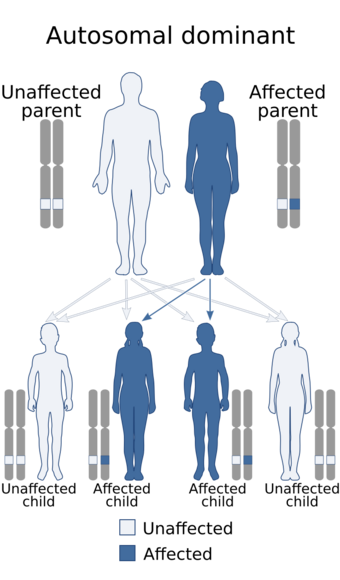Myhre syndrome
Topic: Medicine
 From HandWiki - Reading time: 2 min
From HandWiki - Reading time: 2 min
| Myhre syndrome | |
|---|---|
| Other names | Facial dysmorphism-intellectual disability-short stature-hearing loss syndrome |
 | |
| Myhre syndrome is inherited in an autosomal dominant manner[1] | |
| Specialty | Medical genetics |
Myhre syndrome is a rare genetic disorder inherited in an autosomal dominant fashion. It is caused by mutation in SMAD4 gene.
Signs and symptoms
The clinical presentation is variable but includes[citation needed]
- developmental and growth delay
- athletic muscular build
- skeletal anomalies
- joint stiffness
- characteristic facial appearance
- deafness
- variable cognitive deficits
- tracheal stenosis
- aortic stenosis
- pyloric stenosis
The facial abnormalities include:
- blepharophimosis (an abnormally narrow gap between the upper and lower eyelids)
- maxillary hypoplasia (underdevelopment of the upper jaw)
- prognathism (prominent lower jaw)
The skeletal abnormalities include:
- short stature
- square body shape
- broad ribs
- iliac hypoplasia
- brachydactyly
- flattened vertebrae
- thickened calvaria
Congenital heart disease and undescended testes have also been reported in association with this syndrome.
Genetics
Myhre syndrome is due to mutations in the SMAD4 gene.[2] This gene encodes a protein - transducer mediating transforming growth factor beta. Some researchers believe that the SMAD4 gene mutations that cause Myhre syndrome impair the ability of the SMAD4 protein to attach (bind) properly with the other proteins involved in the signaling pathway. Other studies have suggested that these mutations result in an abnormally stable SMAD4 protein that remains active in the cell longer. Changes in SMAD4 binding or availability may result in abnormal signaling in many cell types, which affects development of several body systems and leads to the signs and symptoms of Myhre syndrome.[3][4]
The patients of this disease exhibit hypertrophic phenotype in their muscle tissues. Myostatin target genes are found to be downregulated while bone morphogenetic protein (BMP) target genes display both upregulated and downregulated genotypes.[4]
Diagnosis
Treatment
History
This disorder was first reported in 1981.[5] It has many similarities to LAPS Syndrome and they both arise from the same mutations in the SMAD4 gene. It is believed that they are the same syndrome.[6]
References
This article incorporates text from the United States National Library of Medicine ([1]), which is in the public domain.
- ↑ RESERVED, INSERM US14 -- ALL RIGHTS. "Orphanet: Myhre syndrome" (in en). http://www.orpha.net/consor/cgi-bin/OC_Exp.php?Lng=EN&Expert=2588. Retrieved 27 December 2017.
- ↑ Caputo V, Bocchinfuso G, Castori M, Traversa A, Pizzuti A, Stella L, Grammatico P, Tartaglia M (2014) Novel SMAD4 mutation causing Myhre syndrome. Am J Med Genet A doi: 10.1002/ajmg.a.36544
- ↑ Shi, Y. & Massague, J. Mechanisms of TGF-β signaling from cell membrane to the nucleus. Cell 113, 685–700 (2003).
- ↑ 4.0 4.1 Le Goff, Carine; Mahaut, Clémentine; Abhyankar, Avinash; Le Goff, Wilfried; Serre, Valérie; Afenjar, Alexandra; Destrée, Anne; di Rocco, Maja et al. (December 2011). "Mutations at a single codon in Mad homology 2 domain of SMAD4 cause Myhre syndrome". Nature Genetics 44 (1): 85–88. doi:10.1038/ng.1016. PMID 22158539. https://www.researchgate.net/publication/51868517. Retrieved 11 July 2015.
- ↑ Myhre SA, Ruvalcaba RHA, Graham CB (1981) A new growth deficiency syndrome. Clin Genet 20: 1-5
- ↑ "Myhre syndrome | Genetic and Rare Diseases Information Center (GARD) – an NCATS Program". https://rarediseases.info.nih.gov/diseases/2572/myhre-syndrome.
External links
| Classification | |
|---|---|
| External resources |
 |
 KSF
KSF